As this series of long-dated observations about The Legend of Zelda nears its conclusion, it’s time to circle back around to the very first post on the topic and look at the overworld design again. Zelda admirably points players in the right direction from the very beginning and “teaches” you how to play as you advance through the dungeons, but the entire overworld layout speaks of a thoughtful design process.
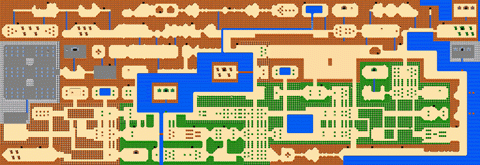
To begin with, the overworld works on a macro scale, as you can see here when it’s all strung together. If we continue accepting the assumption that up equals north, what we have here appears to be a land on the east-southeasterly edge of a landmass. It’s bounded by impassable mountains to the west and north, ocean to the east edging around the southeast corner of the land, and (somewhat less convincingly) impenetrable shrubbery to the south. This forms a perfect rectangle broken into a perfect grid, but whatever, it’s a game. Roll with it.
Within the boundaries of Zelda‘s Hyrule, we have forest occupying nearly the entire south half of the land. The centerpiece of Hyrule is a large, oblong lake fed by a mountain stream and flowing to an unseen sea to the south. A few other ponds appear throughout the land as well. The coasts are appropriately rocky, with some thoughtful little details; I’m fond of the narrow, rocky passage due east of the starting point, which suggests the elevated forest giving way to a more treacherous path to the coastline. To the west, further from shore, the forest is brown and dry, conterminous with a cemetary that serves as the sole entrance to the mountains prior to Link acquiring the ladder that  allows him to ford the river and approach the mountain from the east. There’s also a bit of desert at the foot of the mountain to the north — not much, just a small enclosed valley.
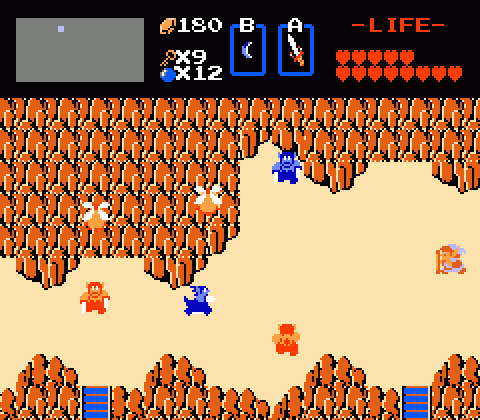
Anyway, the interesting thing about the map design is that, technically, Link can go anywhere he likes from the very beginning. Reaching the northerly peaks isn’t easy at the beginning, since the one path forward is blocked by the Lost Woods, which you’re almost guaranteed not to be able to navigate your first time through; but for subsequent adventures, the land of Hyrule is wide open. This is likely the reason Nintendo built health requirements into acquiring the advanced weapons; by making players track down some Heart Containers in order to wield the better blades, they prevent you from skipping straight ahead to the top weapons before ever entering a dungeon. (Though technically, you can snag the White Sword before attempting your first dungeon if you know where to look for upgrades.) Knowing the route through Hyrule from the very beginning serves as a sort of keystone for speed runs and wacky superplay efforts, including the infamous “reaching Ganon without ever finding a sword” endeavor.
Like much of the rest of the game, Zelda’s overworld teases you with intriguing possibilities, enticing you to explore, then rewarding you for seeking out its boundaries. For instance, while wandering around in search of the second dungeon, which has been tucked away in a dead-end nook in the main forest, you’ll probably notice this Heart Container sitting enticingly on a dock. All you need to reach this is the ladder, but you wouldn’t know that at the time; so you wonder, “How do I get that?” Later, once you have the ladder in hand, you’ll probably remember that one upgrade you couldn’t reach before and head over to find it. And from there maybe you’ll use the ladder to cross the river to the north and explore Death Mountain a bit.
The overworld presents a natural sense of progression as you venture to the north. Creatures grow deadlier as you stray further from the opening area, with Moblins to the east and deadly Lynels patrolling the area around the final dungeon in large numbers. The “proper” path to Level-9 takes you through forest, dying forest, a cemetery, foothills, and finally the peaks of Death Mountain: A clear and coherent journey.
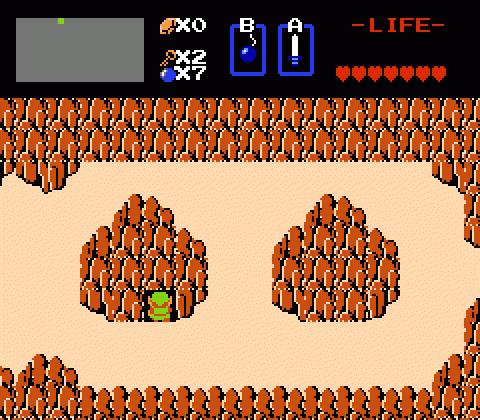
Ah, but we get ahead of ourselves.
Zelda’s overworld also operates on an important unstated rule: Every screen of the map can contain a single hidden door. Not every screen does, but no screen contains more than one. (And every once in a while, you’ll find a screen with both an obvious door and a hidden one, though to my knowledge that only happens at the entrance to dungeons, where the secret door serves double duty as the dungeon’s entrance.) Since so many secrets can only be revealed by bombing or burning the scenery, knowing this limitation saves much time and frustration: Once you find an area’s hidden secret, you don’t need to look further.
Secret doors can be just about anywhere.
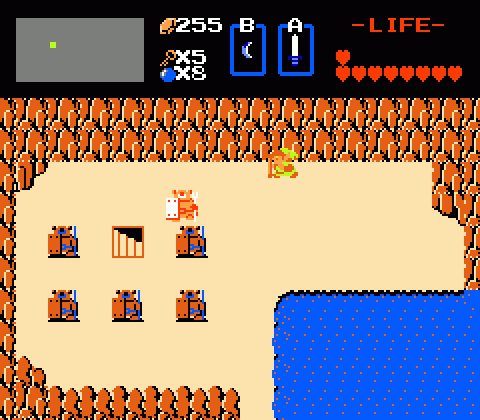
Touch an Armos statue to bring it to life and you may reveal a door.
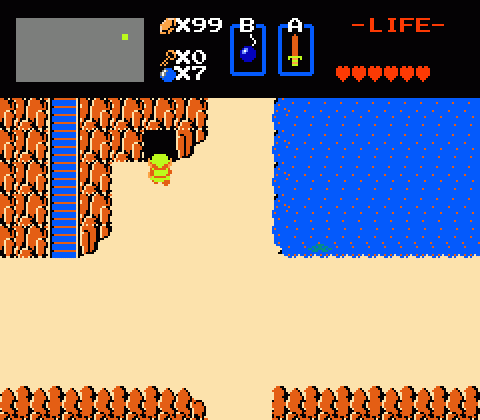
Bomb a rock wall and you could open one.
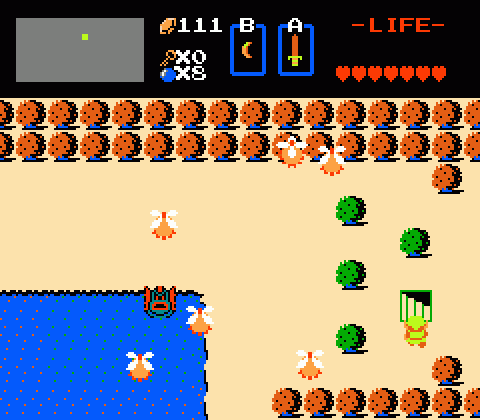
Burn a bush (a breezy task once you have Level-7’s Magic Candle) and a door can appear.
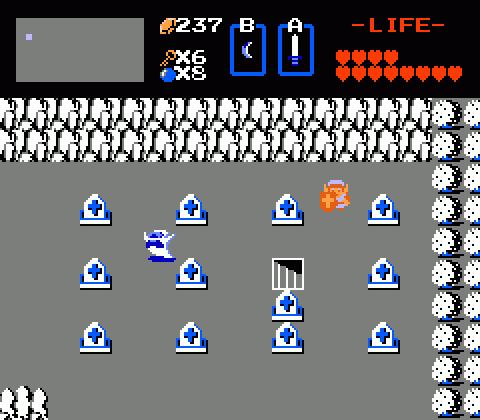
Shove a tombstone, and if a Ghini doesn’t appear to beat you up for disturbing its mortal remains, you just might have found a door.

Move one of those curious rock formations you see scattered around the land. Perhaps they’re related!
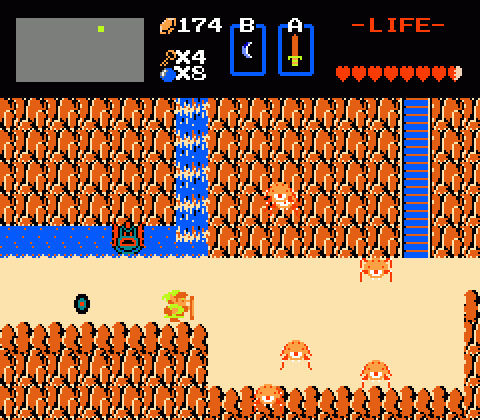
There’s even a direct instruction given in the in-game text: Walk into the waterfall.
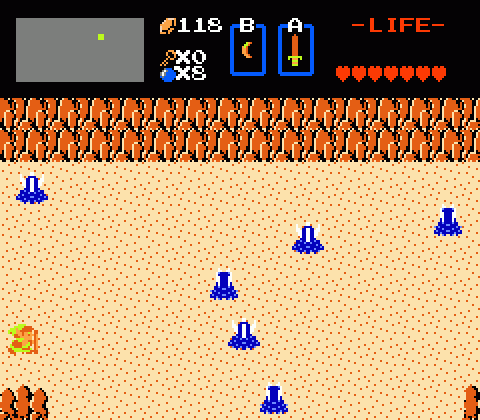
There’s even a really deviously hidden door in the Second Quest desert that can only be revealed by blowing the Whistle.
This constant detonation and arson can grow wearying if you do it all at once, but hunting for secrets in Zelda works best if you attempt it in dribs and drabs. Have some spare bombs on hand while walking through a screen with no visible doors? That one tree standing by itself in the forest seem a little suspicious? Take a few seconds and poke around. Because most of Zelda’s best secrets — the rarest items, the hidden Heart Containers, the cheapest shop deals — only reveal themselves to those who take the time to look.
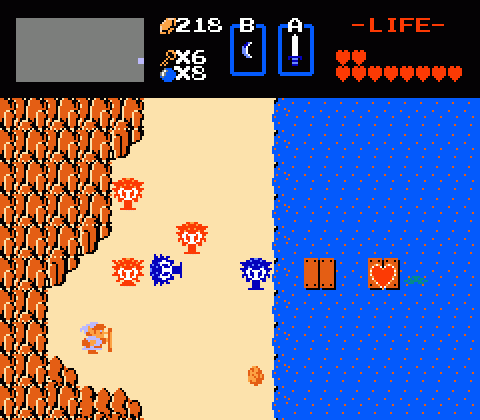
What a perfect explanation for why I still love Zelda 1 more than any of its sequels. There’s a lot that hasn’t aged well about the game, but that world map is just as engrossing now as it was in 1987.
It is a shame that contemporary game world design has seemed to completely pissed on all that has come before it. Things are telegraphed or pointed out, and exploration/discovery has been replaced by cinematics or QTE’s. My hypothesis is that since graphic fidelity is now the primary benefactor of development resource dollars, simple game design rules get dismissed or neglected in order to show off just how clever the X-physics or Y-paricle and lighting engines are. Furthermore, maps used to be an elegant and understated central tool to the gamers experience. World maps are pointless, hell the last 3d world map that flowed together to perfect was the original Jak & Daxter on PS2. . .
I prefer the more optimistic view that there is not (yet) a real career path where someone with a real mastery of the art of game design can be pulled out of a crowd by someone who has a good eye for it and handed a project. There’s a few talented people who got into a position to exercise those talents, largely by luck (correct me if I’m wrong, but Miyamoto got where he is by being able to draw a damn fine minimalist sprite), and none of them that I can think of have lost their touch for it so far.
There’s plenty of older games with no sense of coherent design, and I could name quite a few fancy pretty games with a rock-solid understanding of this stuff as their clear driving force. The real problem is just that it’s harder to give a quick impression of good game design sense than aesthetic sense. I can watch a trailer and see if you can do pretty, but to see if you can do clever I have to sit down and play the finished product.
Let us not get too carried away, here. Primordial Zelda could be awfully frustrating in its vagueness; and its not like all modern games are made by inept monkeys who don’t understand the precepts of good game design.
People always complain about having to burn every bush or blow up every wall, but at leasr in the first quest the rules for secrets really are simple when it comes down to it. Only one potential door or staircase per screen in the overworld, and the only bombable walls are the flat mountain tiles facing the same way a shop door would. The dungeons have even simpler rules for their hidden doors since they can only be located in the center of walls (always between the bolts) or by pushing blocks.
I get the impression that the intent behind two different candles was that in practice, one’s intended for lighting rooms and the upgrade’s more geared towards finding secrets. However, in execution, it just leads to lots of tedious screen transitions trying to find the right bush to burn because it takes way too long to get the better candle.
I am still amazed by the flow of the city in San Andreas, the way neighborhoods flow into one another, and up into the hills, into the forest. It’s a shame Nintendo can’t make a Zelda game with that scope, the current Zelda overworld seems to skew closer to Crash Bandioot levels.
I did not mean to put down those who work hard in the Game Development industry, I just meant to vent my frustration at this notion that seems to exist that gamers need to be explicitly told what to do or where to go next. I feel that it is becasue of this well intentioned but poorly implemented philosophy of making the modern video game a thrilling experience like a Hollywood movie, albeit one with interaction by the user. This forced feeding and coddling has reached a point that when a game like Fallout, or even something remarkably broken like Skyrim (which I do not want to argue about just pointing out how terrible the technical issues were) present the gamer with an open world in which discovery and experimentation are the key element to success, gamers and critic fawn all over it. Now this obviously doesn’t necessarily apply to action or driving games, but there is some discovery there as well that has been lost.
I’ll admit to never playing past Level-2 of the original Zelda, but most of your statements here apply to Link’s Awakening’s Koholint as well. Will you be analyzing it at all?
Sure, eventually. If memory serves, LA has the single most thoughtfully constructed overworld in the entire series.